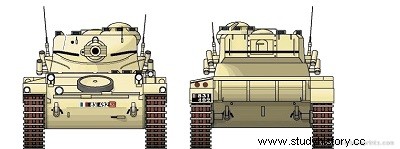
AMX-13, ARV, AVLB and variants
Type :light tank.
Crew :3 men,
Armament :a 75 mm gun; a coaxial of 7.5 mm or 7.62 mm; 2 smoke launcher tubes on each side of the turret.
Shielding :from 10 to 40 mm.
Dimensions:
length (barrel at 12 o'clock):6.36 m;
length (hull):4.88 m;
width :2.5 m;
height :2.3 m.
Weight in combat order :15 t.
Ground pressure: 0.76 kg/cm2.
Engine :SOFAM Model 8 GXb 8 cyl. water-cooled gasoline engine, developing 250 hp at 3,200 rpm.
Performance:
road speed: 60 km/h;
range: 350km;
vertical obstacle: 0.65 m;
clean cut: 1.6 m;
slope: 60%.
Service time: introduced in 1953-1954 in the French army. Also used by Algeria, Saudi Arabia, Argentina, Chile, Ivory Coast, El Salvador, Ecuador, India, Indonesia, Kenya, Lebanon, Morocco, Nepal, the Netherlands, Peru, the Dominican Republic, Singapore, Switzerland, Tunisia and Venezuela. Downgraded by Austria, Cambodia, Egypt and Israel.

The AMX 13 family
Immediately after the war, the army expressed the need for an air-transportable light tank, capable of being deployed to the colonies by the Cormoran transport aircraft.
The Cormoran was eventually abandoned, but the tank was mass-produced and won one of France's greatest export successes.
Adopted in 1951, the AMX 13 is lightly armored, but its mobility, autonomy and above all its firepower are excellent. For 13 tons, the AMX 13 carries a 75 mm gun, the same caliber as the German Panther tank which weighed 45 tons.
The AMX 13/75 and its missile version AMX 13/SS 11 replaced the American M10 Tank Destroyers in the tank destroyer regiments, then equipped the mechanized regiments.
From 1967, the AMX 13/75 were modernized by the installation of the 90 mm CN 90 F 3 gun, to become AMX 13/90, but the AMX 13/SS 11 will remain in 75 caliber until the end of their career. A version, with a 105 mm gun, manufactured from 1963, will be sold for export.
The AMX 13 light tank took part in combat three times, in 1956, during the Sinai campaign; in 1965, in the Indian army during the conflict with Pakistan and, in 1967, during the Six Day War, on the Israeli side.
A complete family of derivatives has been developed on the basis of the AMX 13. One finds in particular the armored personnel carrier V.T.T model 56, which carries thirteen men.
Ordered in 1960 to replace the thousands of American half-tracks in service, it was successively armed with a small armored turret with a 7.5 mm machine gun, then a cupola with a 12.7 mm machine gun.
All ATVs still in service received the single-seat T 20-13 cupola with a 20 mm machine gun; they also exist in Ratac version. P.C. and Sanitary.
The artillery put into service, in 1958, the self-propelled 105 mm, which still equips the artillery regiments of the army corps. In 1968, the self-propelled 155 mm model F 3 appeared, currently employed in the artillery regiments of the . armored divisions.
Other specialized versions based on the AMX 13 chassis have emerged:the model 55 recovery tank, the engineer combat vehicle (V.C.G.) model F 1, the model F 1 bridge layer, the self-propelled 30 mm twin-tube anti-aircraft...
The replacement of this prolific family is in progress, but will take many years. In missions that today require a heavier chassis, the AMX 30 and its derived versions take over, thus the AMX 13/90 is gradually being replaced by AMX 30 tanks in mechanized regiments .
The Au F 1 self-propelled artillery on AMX 30 chassis, formerly 155 GCT, succeeds the 155 mm F 3 self-propelled and the 105 mm self-propelled. In engineering, the V.C.G. F 1 will be replaced by the AMX 30 E.B.G. The 13-ton model 56 V.T.T. gave way to the AMX 10 P and P.C. The AMX 13 model 55 breakdown vehicles were replaced, depending on the regiment, by AMX 30 D breakdown breakdown vehicles or by the VAB-Echelon, just like the AMX .13 Sanitaires would be. by the VAB-Sanitaire. Finally, the model F 1 bridgelayer was withdrawn from service in favor of the P.A.A. (supporting self-propelled bridge).
Thus three different types of armored vehicles are needed to succeed the AMX 13:the AMX 30 for the heaviest versions, the AMX 10 P for mountain bikes and VAB with wheels, more economical than the AMX 10 P for certain specialized versions.
At the present time, the AMX 30 and AMX 10 P equipment is not finished and there are still many mechanized regiments using the AMX 13. Moreover, the VAB being delivered in priority to the infantry divisions, its Echelon or Sanitaire auxiliary versions are not yet available in tank regiments and the AMX 13 family will remain in service for a few more years.
